Category: Presentation
DIS 2021 – Awards
This week I “presented” a full paper and pictorial at the 2021 ACM Designing Interactive Systems (DIS) conference – 10 minute pre-recorded video presentations below – and excited doesn’t quite capture how it feels to share that Entangled Reflections on Designing with Leaky Breastfeeding Bodies received a Special Recognition for Diversity & Inclusion, and Troubling Care: Four Orientations for Wickedness in Design received a Best Paper Honorable Mention Award.
Entangled Reflections on Designing with Leaky Breastfeeding Bodies, DIS 2021
Troubling Care: Four Orientations for Wickedness in Design, DIS 2021
PhD 50% Seminar
Last Wednesday I had my 50% PhD seminar! Sill processing the feedback from my opponent Lone Koefoed Hansen who Zoomed in from Aarhus University, but very thankful for an inspiring discussion.
A short overview of my research can be found here Careful Design: Implicit Interactions with Care, Taboo, and Humor. And an even shorter snapshot of 2.5 years in 16 seconds:
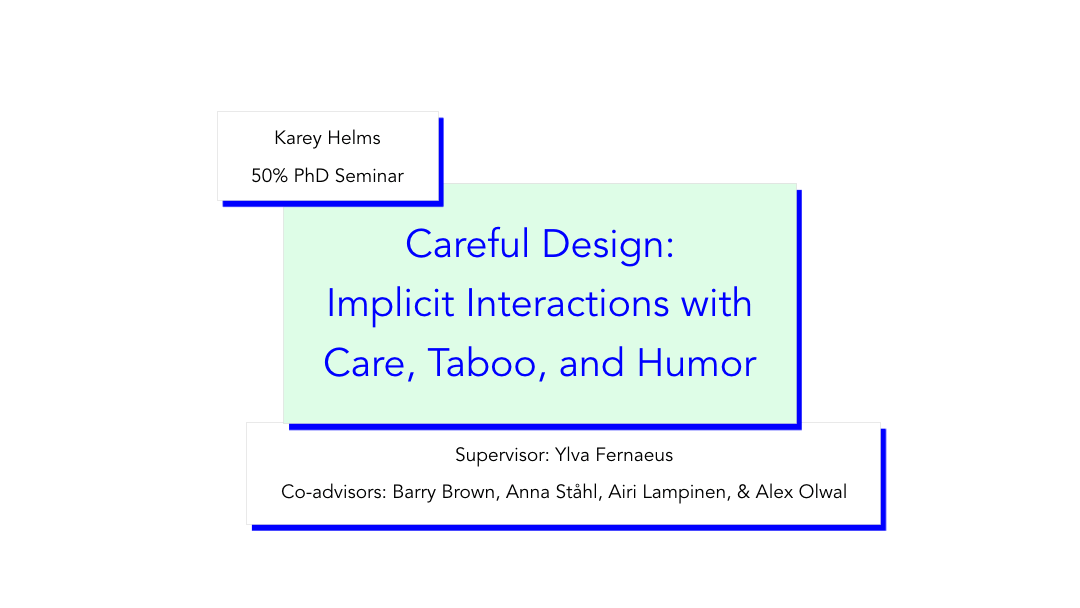
DIS 2019 – Presentation and Slides
Today my paper Do you have to pee? A Design Space for Intimate and Somatic Data will be presented at DIS 2019 in San Diego by a colleague from KTH as I am currently on parental leave with my four week old daughter. Would love to be at the conference presenting and discussing this work, but am more grateful for the conference’s flexibility and Vasiliki Tsaknaki’s assistance in the presentation of this paper while I am instead home in Sweden!
Since this research includes an autobiographic approach and a reflection on my positionality as a design researcher, both of which are critical to the work, the presentation I prepared included both video and audio recording of myself intermixed among a script for Vasiliki (which is why the script includes a mix of first and third person). It was definitely a new challenge rethinking how to make a presentation that included my own voice while using my colleague’s presence for audience engagement! Below is the full written script and slides, and the full paper (which won an honorable mention award!) is available here.
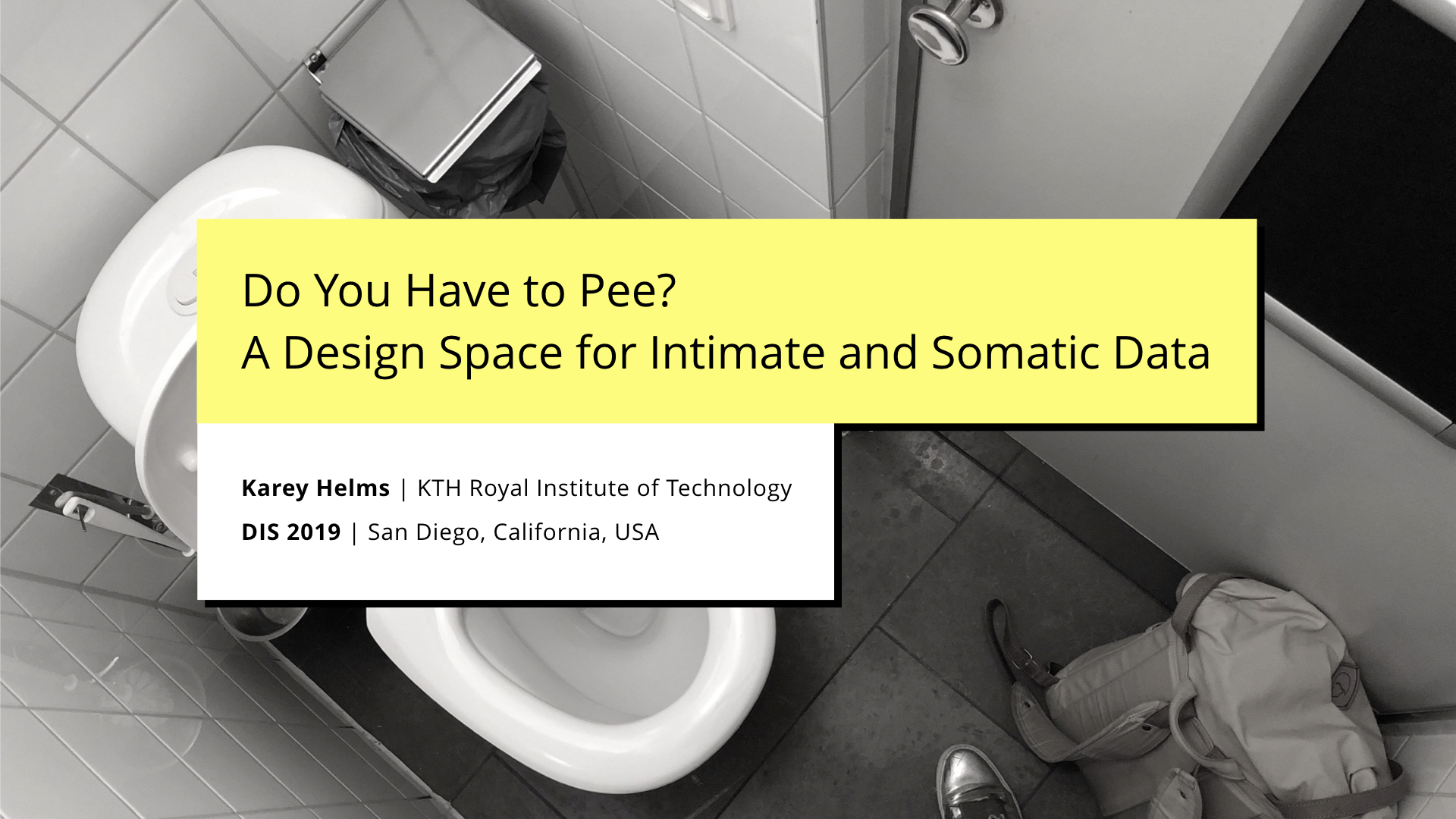
KTH 2018 PhD Supervisory Panel
Today was our department’s annual PhD Supervisory Panel at KTH during which PhD students are given the opportunity to get feedback from senior researchers who act as “guest supervisors.” To prepare for my meeting with two Associate Professors I reworked my research abstract and research questions following my 30% seminar in October, during which Johan Redström from Umeå Institute of Design acted as my discussant. My goals in today’s supervisory panel were to get feedback on the new scope of my abstract and research questions relative to being only about 40% through my PhD (and I’m sure will continue to evolve), and identify important areas that I need to work on articulating to more firmly position my research in the context of how I am conceptually “furnishing” my design space. Considering I was presenting to senior researchers from different academic backgrounds than my own and each other, it was especially helpful to see within which aspect I felt misunderstood, i.e. where I need to sharpen my arguments. Below my poster summarizing my research thus far, followed by a few notes/reflections based on feedback received today, and a textual version of my abstract and research questions.
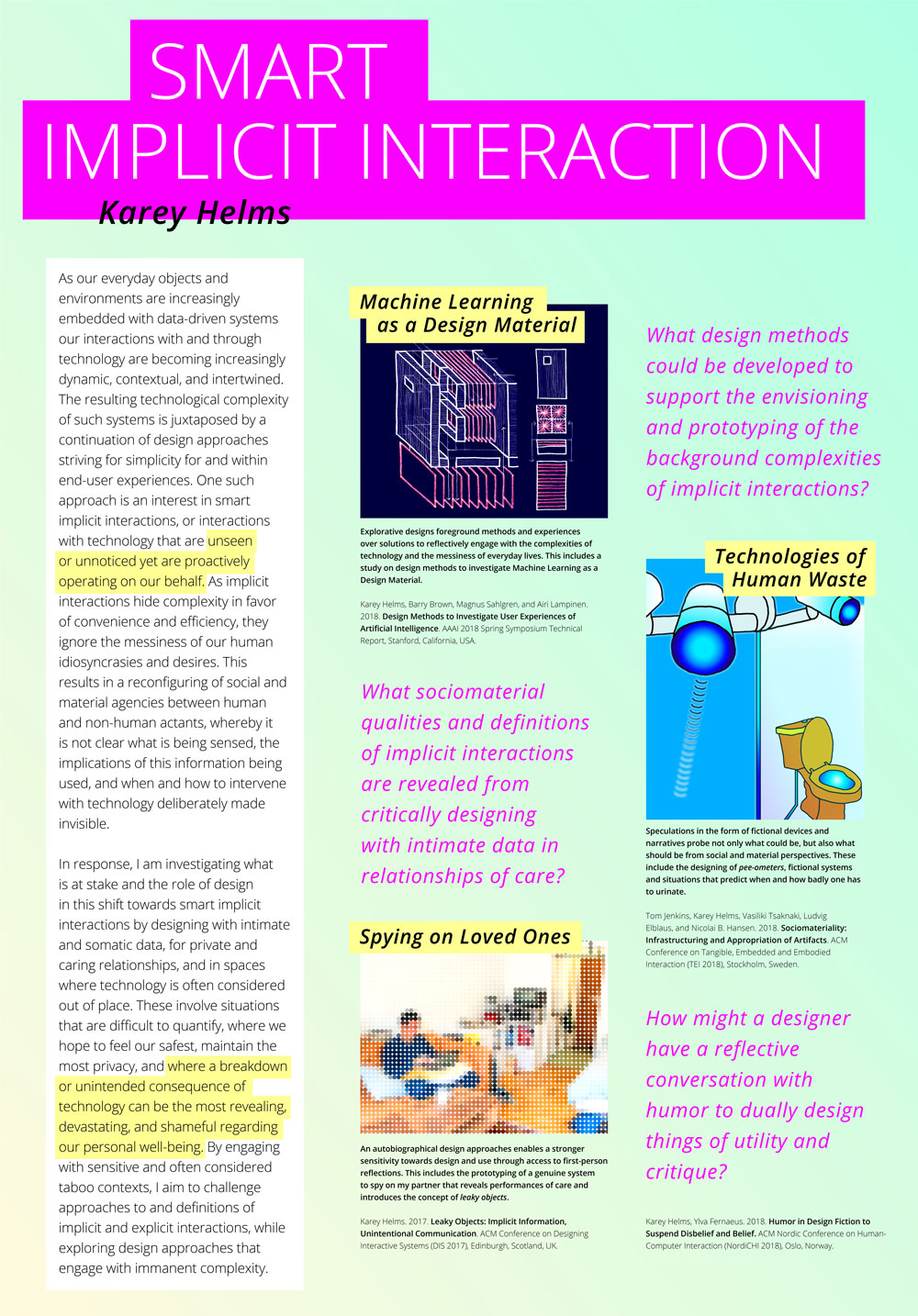
NordiCHI 2018 – Presentation & Slides
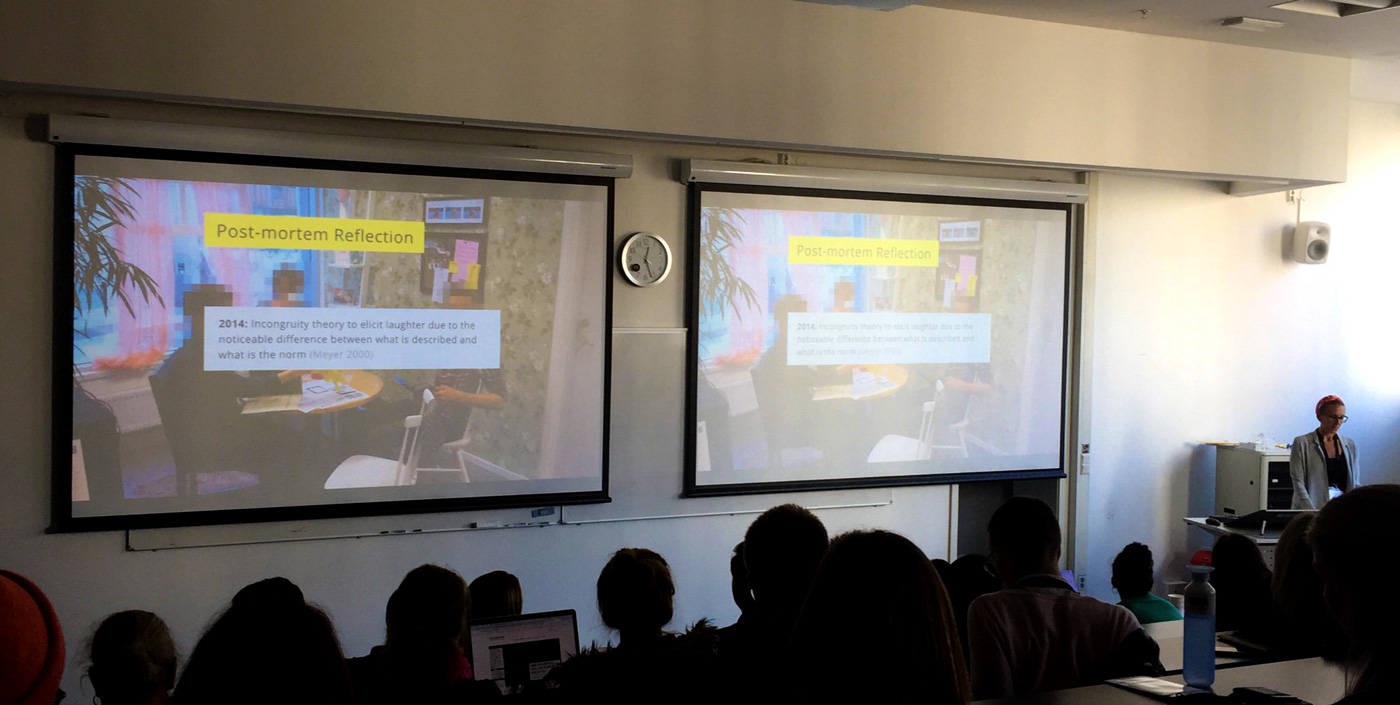
Early this week I presented a paper written with my PhD supervisor Ylva Fernaeus on the use of Humor in Design Fiction to Suspend Disbelief and Belief at NordiCHI 2018 in Oslo. This paper was part of the future scenarios track at NordiCHI, an excellent initiative and venue that explores the design of design fictions. Our paper contributed (1) a way in which humor might be used in design fiction (and design more broadly), (2) a design process that includes fieldwork to inform the design of design fictions, (3) and a human-scale design fiction as a method of communication and dissemination. For the presentation, I originally intended to role-play the paper presentation as a character from the fictional world, as I did when presenting the same project four years ago in Umeå as my master’s thesis, but last minute opted to not because of the opening introductions by moderators. Instead, I opened the presentation by jumping into the fiction with no context, and then gradually introduced more information and built reflections throughout the remaining of the presentation. I think this structure worked very well. The full paper is available here and the presentation below.
PhD’ing – Writers’ Retreat, Project Offsite, Outdoors Research, and Making Preciousness
Today I saw a meme on Instagram which said, “We are now entering the third month of January.” I couldn’t relate more! And looking back over the past few weeks, cannot believe all that has already happened in 2018.
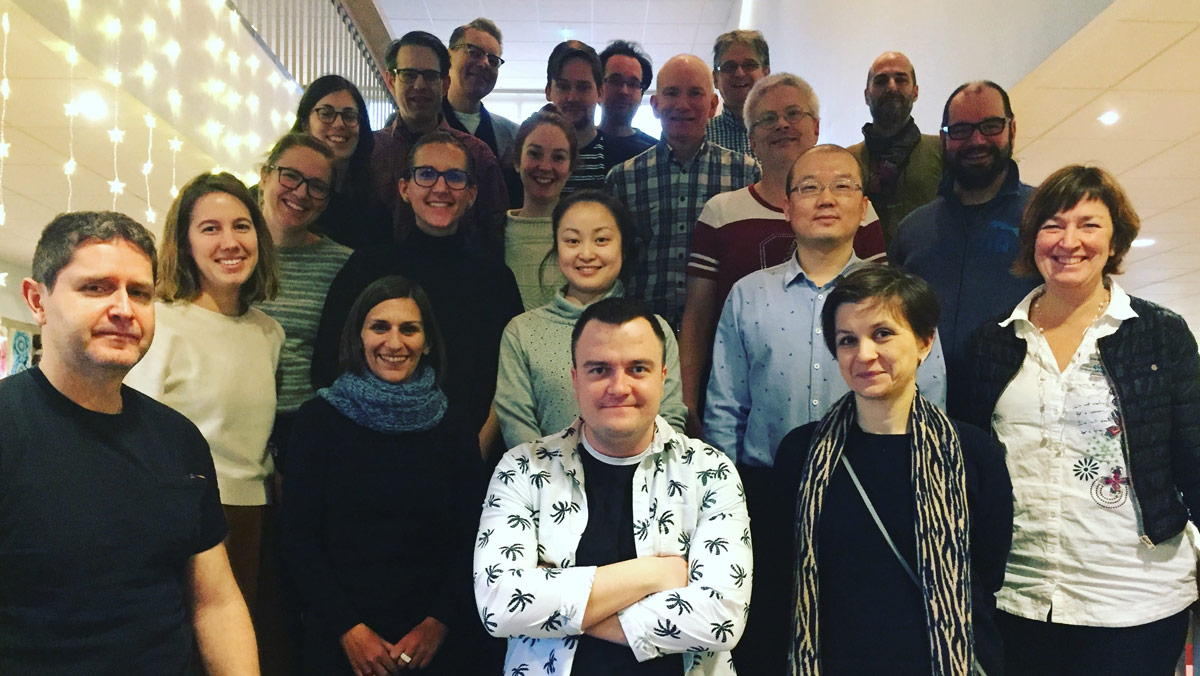
Writer’s Retreat
Following a paper deadline in early January, my department at KTH (Media Technology and Interaction Design) kicked off 2018 with a writers’ retreat. What happens at a writers’ retreat? We book a venue in the Stockholm archipelago for three days and two nights, and write. And sauna and winter swim, but mainly write. The primary purpose of the retreat is to provide time and space away from everyday academic duties, from teaching to admin responsibilities, in order to focus on increasing the quality and quantity of our writing output. During the three days, we follow an agile framework in which junior/senior pairs write in ~45 minute sprints and then provide ~15 minutes of feedback. In addition to intense writing blocks, lunches, dinners, and evening activities provide ample opportunities to better know our colleagues professionally and personally. Though equally as exhausting as the writing, this social time I find incredibly valuable in creating a continued collaborative culture at work.
During this year’s writing camp I started a paper on a Pee-ometer, a recent project by Master’s students that I proposed and supervised in which they prototyped a wearable device that predicts when a user has to pee to investigate Machine Learning as a design material.
Project Offsite
In mid January, the Smart Implicit Interaction project had a two day project offsite. As the project is composed of differing philosophical and methodological backgrounds – i.e. Artificial Intelligence, Social Sciences, and Interaction Design – the first day consisted of a beginners overview into reinforcement and representational learning in neural networks to introduce technical terminology and objectives. During the second day, all of the sub-projects presented their current status and goals for the year. I specifically presented two ongoing design projects, data-driven design methods and the Pee-ometer. In the former, I discussed early design activities and resulting concepts from investigating the implications of screenshots as a data source. In the latter, I discussed three high-level interests guiding future project directions, including Machine Learning as a design material, interactional loops, and critique and ethics. Overall, it was inspiring to share and strategize better collaborations while revisiting overarching project objectives.
Project Offsite
Last week continued January’s streak of out-of-office research activities and into the forest. To kick off an new outdoors project, myself and three senior researchers went on a mid-week day hike 30 minutes outside of Stockholm. Not only was I surprised at a Professor’s ability to make a fire in the snow, but the excursion was both refreshing and constructive. More in the coming months!
Making Preciousness
And last but definitely not least, friend and fellow PhD student Vasiliki successfully defended her thesis Making Preciousness: Interaction Design Through Studio Crafts. Her opponent Ron Wakkary gave a much deserved brilliant presentation of her work before lengthy discussions with him and the committee. Admittedly, it is selfishly bittersweet to see her finishing as she has been a tremendous support and inspiration during the first year of my own PhD.
WIAD16 Bristol – Making the Invisible Physical
Below is the loose script and slides from a 20 minute talk I gave in Bristol for World IA Day 2016 – “Information Everywhere, Architects Everywhere.” I presented personal design projects in which I prototype physical manifestations of invisible interactions from the mundane moments of my daily life, and the resulting insights that inform how I make sense of complex sociotechnical systems and dynamic information exchanges to design meaningful enterprise solutions. More information on the event and other speakers in Brisol can be viewed on the Lanyrd event page.
MFA Thesis – UID Exhibition at Semcon
I was selected to exhibited and present my Interaction Design thesis project, The Family Circuit: A New Narrative of American Domesticity, with a group of other UID graduates for three days at Semcon in Göteborg, Sweden.

Thesis Mid Review Presentation
This past Thursday and Friday were IxD2 thesis mid review presentations. Below are my presentation slides and annotations. Text written some odd place in between formal snippets taken from my report and my quite colloquial style of presenting. All background photos are my own unless stated otherwise.

Because every presentation should begin with a different quote!